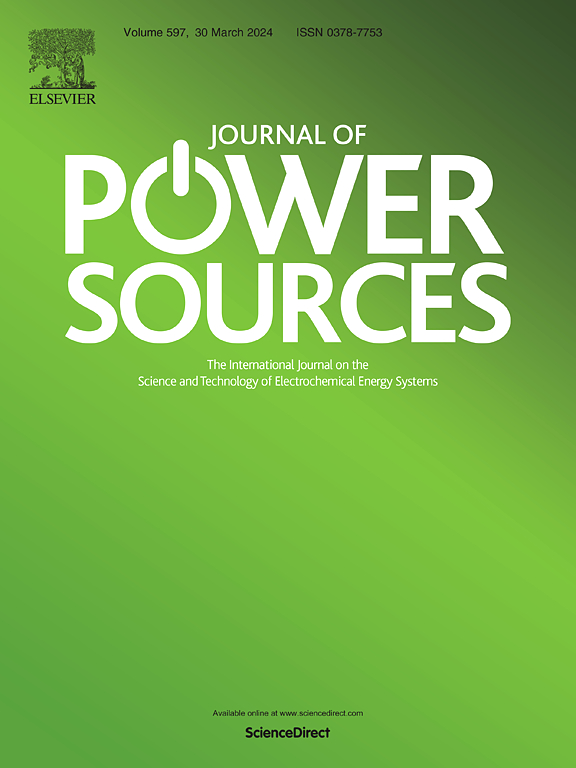揭示了Ce掺杂La0.6Ca0.4Co0.2Fe0.8O3-δ作为固体氧化物燃料电池高效阴极的促进作用
IF 7.9
2区 工程技术
Q1 CHEMISTRY, PHYSICAL
引用次数: 0
摘要
钙钛矿La0.6Sr0.4Co0.2Fe0.8O3-δ (LSCF)是迄今为止研究最多的用于固体氧化物燃料电池(sofc)的高性能正极材料,但高温下的锶偏析严重损害了LSCF阴极的活性和寿命。用Ca取代Sr,即La0.6Ca0.4Co0.2Fe0.8O3-δ (LCCF),可以增强钙钛矿的稳定性,但代价是降低了催化活性。本文采用有效的a位Ce掺杂策略来改变LCCF的结构和化学性质,从而提高其电化学性能,即La0.6Ca0.4-xCexCo0.2Fe0.8O3-δ (Ce- lccfx, x = 0.05-0.2)。结果表明,用Ce4+取代Ca2+显著改变了钙钛矿中氧空位浓度、Fe4+/Fe3+和Co4+/Co3+的比例。结果表明,当Ce-LCCFx中x = 0.15时,LCCF的热膨胀系数大幅降低至12.6 × 10−6 K−1。此外,负载Ce-LCCF15阴极的单电池在750°C的H2中表现出1.26 W cm−2的最大功率密度。有趣的是,微观结构分析表明,由于阴极电流极化,大量的CeOx纳米颗粒从Ce-LCCF15表面原位析出。本研究有助于理解掺杂剂对SOFCs正极材料催化性能的促进作用。本文章由计算机程序翻译,如有差异,请以英文原文为准。

Unveiling promotion effects of Ce doping in La0.6Ca0.4Co0.2Fe0.8O3-δ as an efficient cathode for solid oxide fuel cells
Perovskite La0.6Sr0.4Co0.2Fe0.8O3-δ (LSCF) is to date the most intensively studied high-performance cathode material for solid oxide fuel cells (SOFCs), but strontium segregation at elevated temperatures critically impairs the activity and longevity of LSCF cathode. By substituting Sr with Ca, i.e. La0.6Ca0.4Co0.2Fe0.8O3-δ (LCCF), the stability of the perovskite can be reinforced, however, at the cost of reduced catalytic activity. Herein, we adopt an effective A-site Ce doping strategy to modify the structure and chemistry of LCCF and therefore to boost its electrochemical performance, i.e. La0.6Ca0.4-xCexCo0.2Fe0.8O3-δ (Ce-LCCFx, x = 0.05–0.2). The results reveal that replacing Ca2+ with Ce4+ notably alters the oxygen vacancies concentration, Fe4+/Fe3+ and Co4+/Co3+ proportions in the perovskite. As a result, the thermal expansion coefficient of LCCF is drastically lowered to 12.6 × 10−6 K−1 upon x = 0.15 in Ce-LCCFx. Moreover, the single cell loaded with Ce-LCCF15 cathode demonstrates a superior maximum power density of 1.26 W cm−2 at 750 °C in H2. Interestingly, microstructure analysis suggests that abundant CeOx nanoparticles are exsolved in situ from the Ce-LCCF15 surfaces due to cathodic current polarization. The present study contributes to the understanding of the role of dopants in promoting the catalytic properties of cathode materials for SOFCs.
求助全文
通过发布文献求助,成功后即可免费获取论文全文。
去求助
来源期刊

Journal of Power Sources
工程技术-电化学
CiteScore
16.40
自引率
6.50%
发文量
1249
审稿时长
36 days
期刊介绍:
The Journal of Power Sources is a publication catering to researchers and technologists interested in various aspects of the science, technology, and applications of electrochemical power sources. It covers original research and reviews on primary and secondary batteries, fuel cells, supercapacitors, and photo-electrochemical cells.
Topics considered include the research, development and applications of nanomaterials and novel componentry for these devices. Examples of applications of these electrochemical power sources include:
• Portable electronics
• Electric and Hybrid Electric Vehicles
• Uninterruptible Power Supply (UPS) systems
• Storage of renewable energy
• Satellites and deep space probes
• Boats and ships, drones and aircrafts
• Wearable energy storage systems
 求助内容:
求助内容: 应助结果提醒方式:
应助结果提醒方式:


